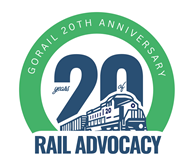Chamber News
Railroads and Ohio’s Manufacturing Renaissance | GoRail | CRLC May Insider | May 2024
May 30th, 2024

Written by: Michael B. Gaynor, Assistant Vice President, Field Operations, GoRail
While Ohio manufacturing peaked during WWII when it supported nearly half of the state’s jobs, we’re still home to some 13,000 manufacturing businesses employing 10% of Ohio workers. The same trends that led to offshoring so many decades ago are now reversing and fostering a burgeoning Ohio manufacturing sector.

Reshoring and foreign direct investments in 2022 created more than 360,000 U.S. manufacturing jobs, a 53% increase over the previous year, which was also a record. Geopolitical instability, demographics, supply chain vulnerabilities, and evolving manufacturing techniques are just some of the many factors contributing to a new global realignment.
In 2022 alone, Ohio brought in a staggering $31 billion in corporate capital expenditure commitments from three megaprojects and hundreds of smaller new developments and expansions. In a few weeks the annual Columbus Opportunity Summit will focus on this resurgence, highlighting investments from Honda, Intel, American Nitrile, and others, while also discussing how Central Ohio can prepare for more growth.
Logistics is a primary driver of our success across the state and particularly in Central Ohio, a hub for freight transportation. And the keystone of our infrastructure is its robust rail connections that help manufacturers reduce costs and enhance their competitive advantage here in the U.S. or globally.
Ohio has the third largest rail network and the second highest number of intermodal terminals in the nation. Our 43 different freight railroads—four large, “Class I” railroads and 39 smaller regional and short lines—operate across 5,200 track-miles and support 5,000 employees earning an average of $128,000 in salary and benefits.
Many of the new companies coming to Ohio rely on rail, which is typically the most affordable way to move freight on land. Most notable is the Honda and LG Energy Solutions joint battery factory under construction in Fayette County. The $3.5 billion facility, expected to create 2,200 jobs, will utilize rail connections. Believe it or not, most of North America’s 70-plus automobile manufacturing plants—like the four Honda plants already in central Ohio—are similarly served by rail, with trains moving 75% of the new cars and light trucks purchased in the U.S.
There are more examples of freight rail facilitating job growth in the state. Between 2019 and 2022, the Ohio Rail Development Commission provided $15 million in grants or loans that were matched with $109 million in private investments to fund 66 manufacturing projects supporting 11,500 jobs. From hot rolled steel near Toledo, to pet food production outside of Cincinnati, to paint production and recycling in Columbus, we are seeing more examples of rail-driven growth locally and across the state.
Nationally, railroads move across the top-graded infrastructure system in the U.S., with the American Society of Civil Engineers (ASCE) attributing this achievement to massive private investment from railroads into their networks.
Were it not for rail networks, all this freight would be on our already-strained highways. In fact, the freight hauled by trains takes 14.7 million trucks off our roads annually. Less freight on rail and more on highways would mean more congestion and higher costs to businesses and consumers—an issue that would be especially acute as demand in central Ohio surges.
Railroading in the Buckeye State dates to the 19th century. A lot has changed since the early days of statehood, but freight rail remains an economic driver. As Governor Dewine proclaimed during his 2022 State of the State address, “New manufacturing companies are locating all over Ohio.” Continued private sector investment in rail combined with smart public policy is critical as we enter a new manufacturing era.

Christine Boucher
Director, Columbus Region Logistics Council
christineboucher@columbus.org

